Have you ever heard of “Surf Champ,” the world’s first digital surfing simulator? This 1985 ZX Spectrum game was sold with a miniature surfboard that balanced on the computer’s keyboard.
Meet Norman McMillan. He was born in 1945 in Ontario, Canada, and raised in the United Kingdom by an English mother and a Canadian father.
At the age of 40, McMillan was already an active and well-respected scientist with articles published in journals, and executive responsibilities in British and Irish academic institutions.
He had also contributed to the development of the first applications of imaging in physics laboratory teaching and several groundbreaking engineering programs.
Norman McMillan is acknowledged as the founder of tensiography, the graphical computer analysis that allows for monitoring and measurement of signals obtained from various sensors deriving their responses from growing liquid drops.
But McMillan was also a keen surfer.
He started riding waves in the 1970s, and he wanted to create something that would blend his passion for surfing with a commercial project.
In the early 1980s, computer gaming was starting to pick up.
“I wanted to get into sports simulations, but I wasn’t sure how until June 1984,” McMillan said at the time.
“I was a surfer, and as a physicist, I knew I could do a computer game with a proper mathematical algorithm so it would be accurate.”
Norman McMillan teamed up with fellow academic John Frayne and astrophysicist Susan McKenna-Lawlor to develop what might be the world’s first computer surfing game.
Each one of them invested £20,000 in New Concepts, the company that would create “Surf Champ.”
The project’s motto was highly appealing – “the game that teaches you how to surf.”
With an extra financial push from the Industrial Development Authority (IDA), the game was put to the test in the hands of those who could approve it or not: surfers.
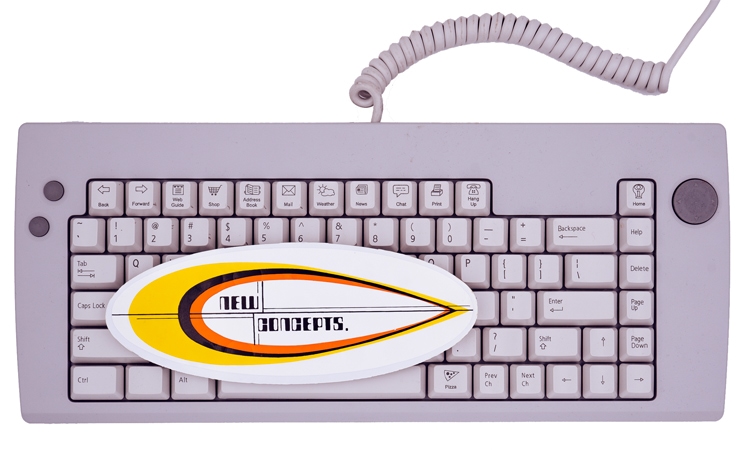

The Computer Surfing Championship and the Miniature Plastic Surfboard
On a flat day at the 1985 European Surfing Championships held in Rossnowlagh Beach, Donegal, Ireland, competitors were invited to play the game.
The truth is that they all loved it. It mimicked the surfing experience.
New Concepts realized they could crown a champion in a parallel event to boost interest in their product.
The contest was named World Computer Surfing Championship.
Jed Stone, then the reigning English surfing champion, also managed to clinch the inaugural gaming event.
The follow-up marketing strategy of “Surf Champ” involved offering cash prizes to those who were able to beat Stone’s digital high-score.
Back then, he scored 23,700 points. But no one ever broke his record.
“I got caught up in the competition at the inaugural World Computer Surfing Championship in the same as I do in real surfing competitions,” Stone stated in a New Concepts ad released weeks later.
“I really wanted to win the New Concepts Surf Board Prize. I can assure the game’s player that this sports tutor gives them the closes possible simulation of my sport.
“Surf Champ” was more than just a ZX Spectrum game.
You actually had to play it with a 19-centimeter 3D surfboard control pad that sat on a special button on the keyboard and bobbles on the bottom that pressed down on different areas depending on your hand movements.
As a result, the player had to balance his fingers on the miniature plastic board to accelerate, perform a bottom turn, and ride the wave flawlessly until the end.
The developers made sure software accurately models with waves and other conditions.
So, in a way, you could market it as an inland surfing simulator.
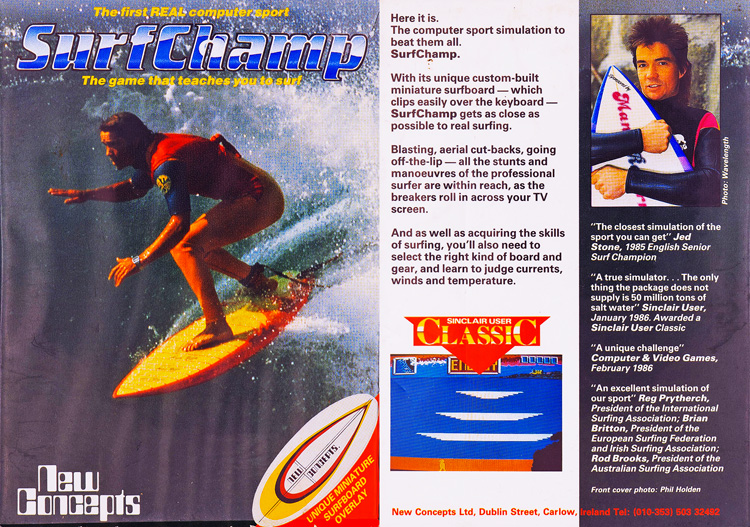

Opportunity Knocked But…
In October 1985, Norman McMillan went to London to find distributors for the game. One of them asked him to produce 200,000 copies for the upcoming Christmas season.
The idea was to sell them for £12, with New Concepts getting £4 for each copy sold.
However, IDA was not willing to take the risk and fund a project in an industry that was still relatively unknown and uncertain.
As a result, McMillan and his partners were only able to produce 3,000 copies, which immediately sold out.
“The most realistic sports simulation ever” was re-released a few months later in 1986 for Commodore 64, but the company only sold 600.
The dream turned into a nightmare. “Surf Champ” has just wiped out.
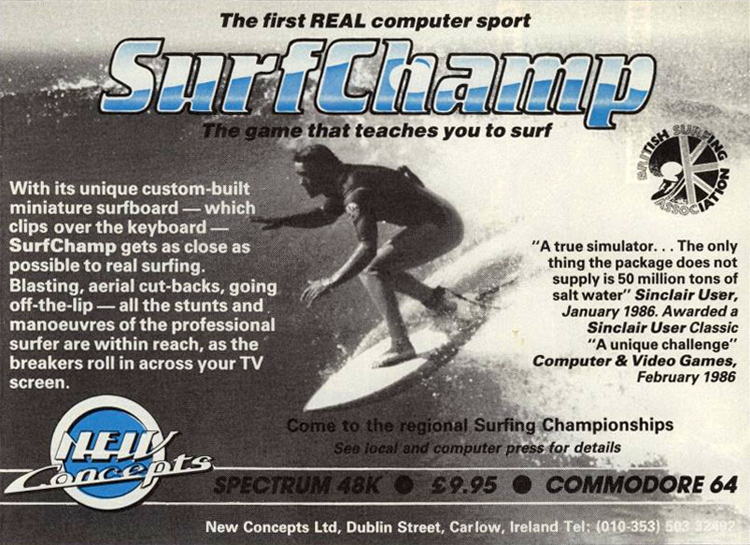

The Reviews
“Surf Champ” received mixed reviews from gaming critics. Take a look at the most relevant analysis.
“The game is a true simulator – you can practice in fairly calm conditions or try for a high score on the ranking table. The only thing the package does not supply is 50 million tons of salt water. Surf Champ won’t do much for your style if you’re a real surfer, but it gives the feel of the sport. I’m not sure that the plastic control paddle is as indispensable as New Concepts claims – I was able to surf quite happily without it – but it is an incentive which players are bound to appreciate.”
Sinclair User, January 1986
“Using the miniature surfboard is very frustrating to begin with, but with practice, it becomes easier. Graphically the game is a little crude, but if you fancy a unique challenge, then you’ll get a square deal from Surf Champ.”
Computer & Video Games, February 1986
“Nottalotta people might like this, but I loved it.”
Your Sinclair, February 1986
“While New Concepts have come up with a good idea and have created a very interesting and different sports simulation, they should have paid more attention to the front end of the game. The instructions are very difficult to master, as is the game itself. If you are already a surfer, you’ll probably drop straight into it, but most people will have to put a fair bit of effort into getting to grips with the game. That said, if you take the trouble, SurfChamp can be a lot of fun, and could teach a lot about the sport is simulates. With a bit more attention to presentation, New Concepts could have had an excellent product.”
Crash, April 1986
“It remains a tribute to lateral thinking in game design and deserves a cult corner in the collection of any serious archivist.”
Advanced Computer Entertainment, March 1991
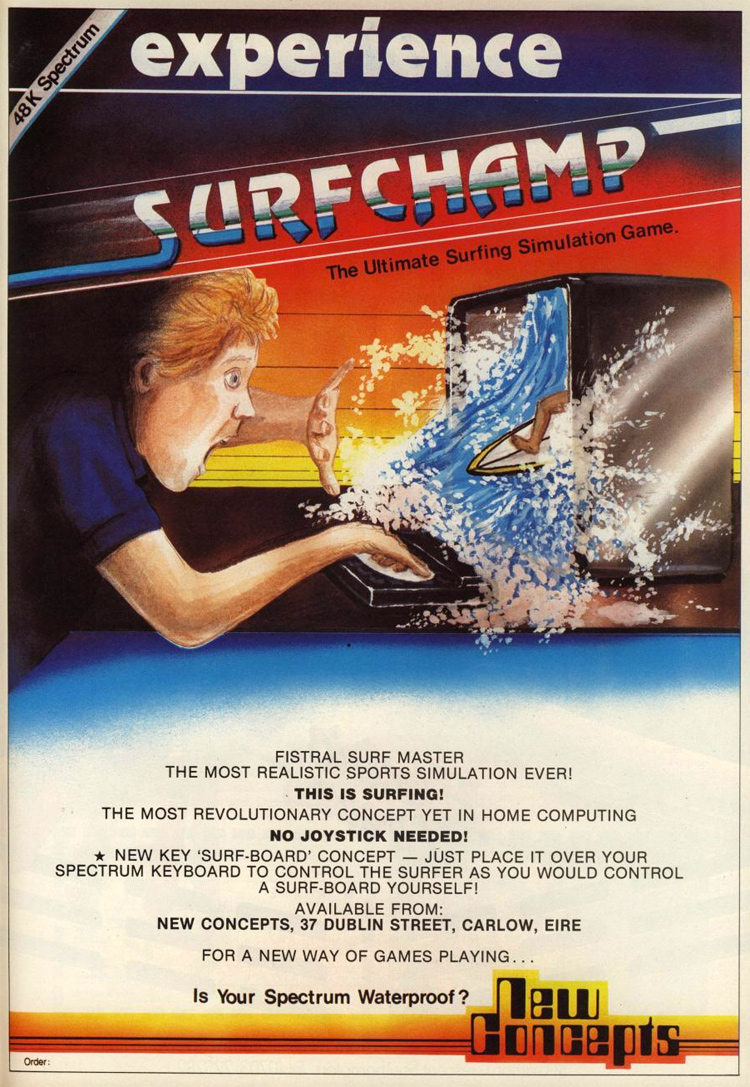

Before and After ZX Spectrum’s “Surf Champ”
Interestingly, the world’s first “Surf Champ” was not a ZX Spectrum game. Instead, it was a pinball game created in 1976 by D. Gottlieb & Co.
The arcade game has been hailed the best pinball surfing machine of all time with between 1,000 and 4,000 units manufactured.
The glass-covered cabinet featured the traditional flippers, slingshots, pop bumper, star rollovers, one spinning target, one kick-out hole, and five-bank drop targets.
New Concepts’ “Surf Champ” was followed by “California Games,” a title that featured surfing, skateboarding, BMX, roller skating, footbag, and flying disc.
The 1987 game hit the market for the Apple II and Commodore 64.
In the first nine months, the Epyx title sold over 300,000 copies and was later considered one of the best computer games of all time.
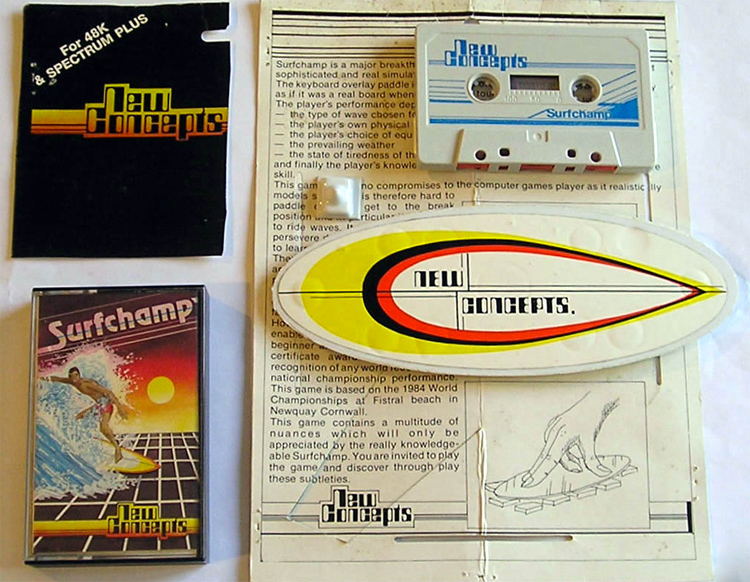

Play the Game
“Surf Champ” was originally released for ZX Spectrum and Commodore 64. But you can still try it today.
All you need is to install an emulator like Fuse (Mac and Windows) and run the .tzx or .tap files available in worldofspectrum.org.
The surfer’s physical characteristics, his board selection, the weather, the tide conditions and other factors all make the game different every time he takes his boards down to the beach.
The surfers build up their skill and knowledge, and it is this which will ultimately determine who will become the “Surf Champ.”
A unique Hall of Fame and a multitude of other small but meaningful nuances make this game really stand out from all other sports simulations.
There is a fully illustrated information mode for beginners on a separate loading.
This simulation enhances the various difficulties incorporated in small wave surfing and the characteristics of the famous Fistral Beach.
New beaches were expected to become available to surfers wishing to follow the surfing trail all the way to the massive Pacific rollers in Hawaii.
That, however, never happened. So, enjoy Cornwall’s Fistral Beach.
Place the locator on the G key.
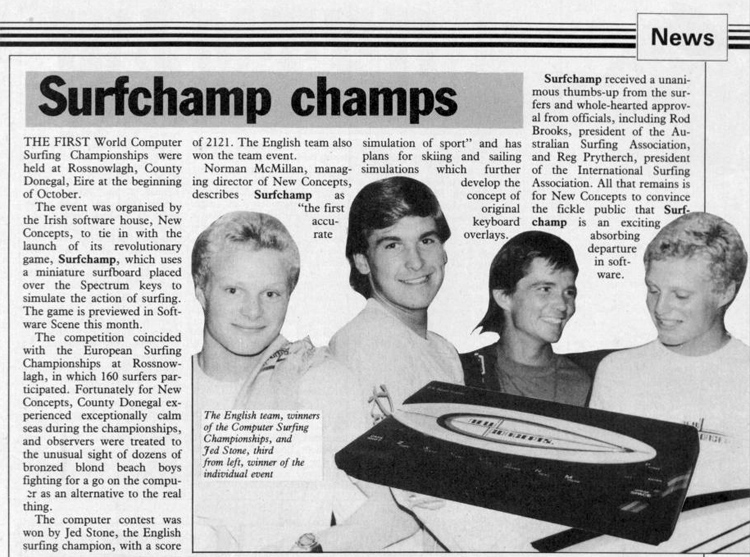

Game Instructions
1. Menu Section
The player is asked to give personal details.
It is important that these are accurately given if a world record or national record is to be awarded since these details must be recorded along with the record-breaking score.
These details also determine the performance of the board, and it is necessary for the surfer to choose the correct board for their own height and weight.
2. Paddle Out and Wave Catch
The surfer can enter the water from the beach at any point. Once in the water, the surfer must paddle.
Oncoming waves will knock the surfer off the board if he does not porpoise or if he porpoises at the wrong angle to the wave.
Once off the board, the surfer is carried back a short distance.
If the surfer does not remount before the next wave hits, then the surfer will be carried back with the wave all the way to the beach unless action is taken to get off the wave.
The surfer can get out more easily by avoiding as far as possible the broken waves as it is not, in this case, necessary to porpoise.
The surfer must turn to catch the wave, and this can only be achieved at a point where the wave has broken.
There is a sweet spot at the breaking point where the surfer will get an extra push.
The surfer can belly board in and turn left or right on the wave, but if the stand key is pressed when the wave is caught, then the surfer will transfer to the perspective view after take-off.
The surfer will lose energy during paddle out and should seriously take into account this aspect of the game.
3. Practice Mode, Competition Mode, and Scoring
In the practice mode, the surfer does not lose any energy and can practice any maneuver.
At the end of the ride, the wave will be scored. There are ten speeds in this mode.
The surfer’s score is displayed along with the energy units they have left.
If the surfer gets tired, then his or her performance will deteriorate.
The score will be based on ten rides, and the competition rules will apply.
The competition rules are displayed after the selection of surf gear.
Prizes are available for record scores.
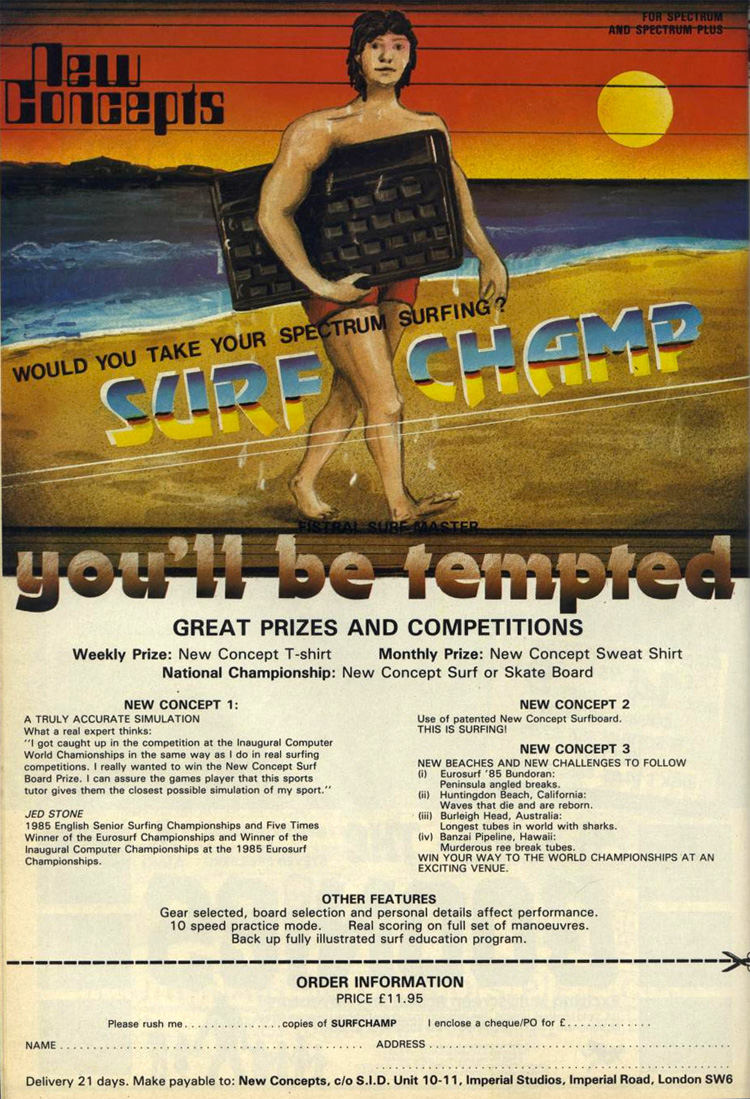

4. Hall of Fame
Recorded in the Halt of Fame is the score and name of the current world champion player.
Scores of a number of surfers can be kept in this Hall of Fame, and these are scored in a League Table order.
5. Information Mode
This section can be loaded in after the game and describes wave types, equipment, explains surfing slang and lists and describes how the maneuvers are done.
Some of the information in this section is relevant to the game itself.
6. Strategy
Selection of Surf Gear
Beginners would be well advised to select a pop- out and as regards board length should choose a board a foot longer than their height.
Advanced surfers should choose a more advanced board to make all the maneuvers possible and a board 2-6 inches longer than the height they put in.
Wetsuits suitable for the sea and air temperature should be chosen. For more info on this, see the information mode.
7. Key Press
On the Beach
To move right, press Caps;
To move left, press 1;
To place the board in water, press the nose of the board;
Paddling Out (Hand Flat-Laying)
To move right, press Caps;
To move left press 1;
To move straight, press Caps and 1, alternately;
To porpoise, press the nose of the board;
To remount, press the nose of the board;
To catch a wave and stand, press 2;
Riding and Board Turning (Hand Raised – Standing)
Slow – front side;
Medium – middle side;
Sharp – rear side;
Aerial: To turn the board in air press left L right P;
Hand down on the back of the board: Press back of the board and 9 Hand in water (slows board to stay close to the break). Press back of board and P;
Hang 5: Press 1 or Caps;
Hang 10: Press 1 and Caps;
Wave balk: Press the back of the board to avoid surfer being carried onto the beach;
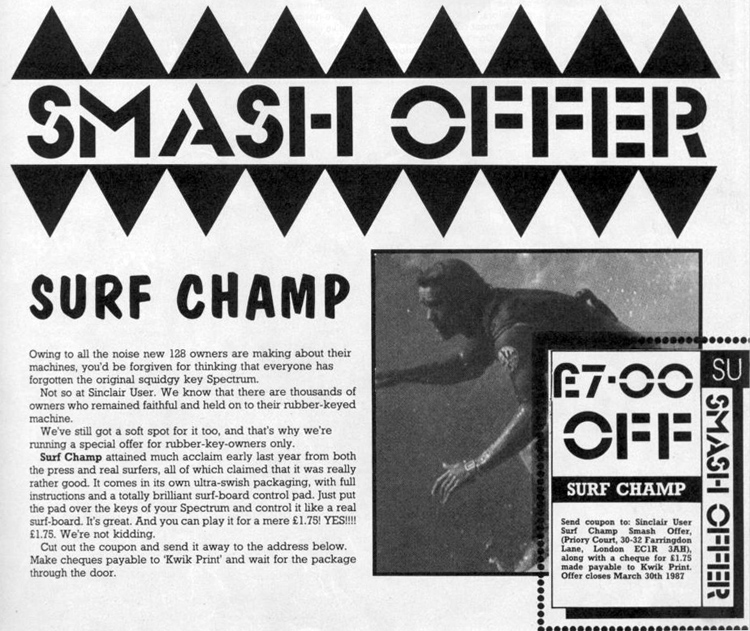

8. Board Selection
Boards
1. Pop-out – for beginners;
2. Single fin custom/more maneuverable;
3. Twin fin/slides more than single fin;
4. Two and a half fins/more subtle;
5. Three fin thruster – big wave;
Gear
1. Pod – suit with no legs and arms;
2. Summer Suit;
3. Winter Suit;
4. No Suit – for really hot conditions;
5. Leash to tie the board to surfer;
After selection, press X.
Paddle Out
On paddling out, the rip should be used to the player’s advantage.
For the extra push needed for more advanced maneuvers, the waves should be caught at the sweet spot.
The soup should be avoided, as it is only possible to bellyboard in it.
Competition Mode
Energy loss should be prevented as far as possible as it is only possible to surf as long as the given amount of energy lasts.
Remember that energy is being used all the time, and wipeouts make up a large part of this energy loss, so be ready to bomb out to avoid wipeouts and, therefore, the loss of energy.
9. Scoring Maneuvers
Take-off: 40
Riding the Soup: 10
Riding: 10-100
Bottom Turn: 120
Radical Manoeuvres: 100 – 200
360: 240
Aerial: 100
Blasting: 120
Off the lip: 120
Aerial Cutback: 480
Re-entry: 50
Re-entry and riding: 100
Hang Five*: 40
Hang Ten*: 60
Hand Down*: 40
*Time-dependent score every keyboard read.
10. World Record Holder
Jed Stone: 23,700 points. Winner of the inaugural World Championships held at Eurosurf 1985 Championships, Rossnowlagh, October 1, 1985.


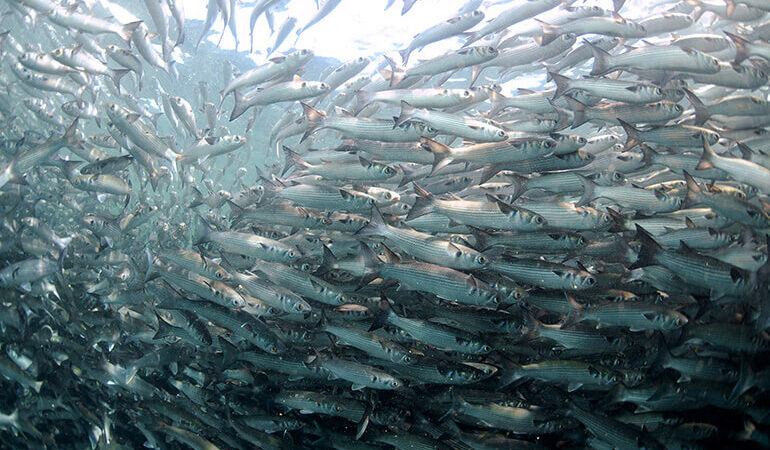

Recent Comments